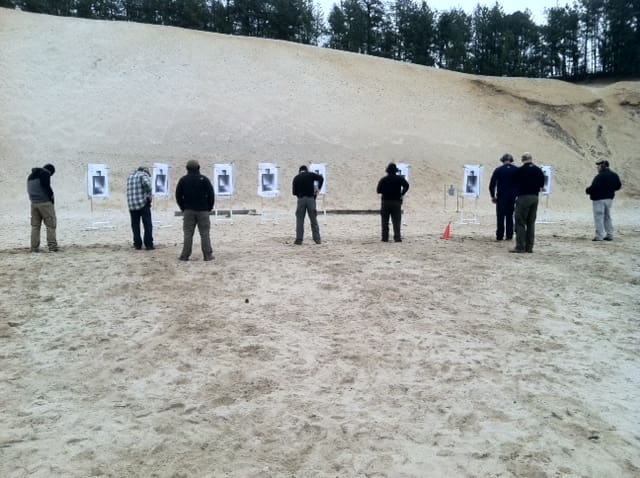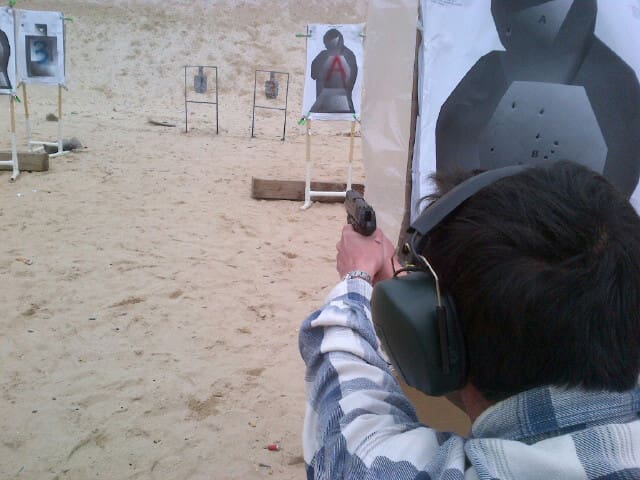Tyler Kee is in the middle of his series on getting his CCW training in Texas and I saw how much he liked his instruction. So when I read about MDTS after hearing only good things locally, I signed up. Although there’s plenty of debate in the firearms community on the issue of forcing citizens to undergo training, there’s no doubt about the merits of taking a good class or two. However, the MDTS Combative Pistol 1 and 2 class is probably beyond what a typical out-of-the-box noob can handle . . .
A novice would be good after a month and putting 500 rounds of slow fire downrange before signing on for this one. Or something like that. Sixteen of us rolled into the Calverton shooting range at 8:30 a.m. on Sunday. It’s one of the only private areas on Long Island that will host a firearms training class.
Usually, this range is the local hangout if you want the pleasure of frequently being lasered by novices. However, the MDTS class is situated in the range’s neverlands, out past the burning tire compost and beyond the carcasses of decrepit recreational vehicles. We set up shop well away from the yahoos looking to punch holes in paper at the ‘public’ section of the private range, but the reports from ricochets were nevertheless a little disconcerting. Our class was behind a berm of dirt that looked like more than a few bodies could be buried there.
The class opened with a safety briefing and getting to know lead instructor, Chris Fry. Fry’s teaching style is spot-on. He doesn’t preach anything – if you’ve figured out a way to do something better, he is all ears. However, after teaching hundreds of classes he pretty much knows the best way of doing something with the most difficult firearm to master – the pistol.
What makes Fry more amazing is he doesn’t come from a military or law enforcement background, yet you would think he’s a seasoned veteran. But his civilian attitude and teaching style is a breath of fresh air compared to the drill sergeant instruction I hear some classes feature. He peppers the curriculum with just enough salty language to keep the youngsters interested.
Fry led the class in a discussion of when lethal force is applicable in New York State. I couldn’t help but interject a note about TTAG’s corporate STFU policy. Fry even took it one step farther, suggesting that you say ‘I really want to be cooperative, but right now I’m not feeling right. Can you take me to the hospital?’ Machismo aside, taking a short ambulance ride and getting medically checked out is a stroke of brilliance. It allows you to regain composure as well as get in touch with your attorney on the Econoline ride over.
We then started the fundamentals of shooting section where accuracy was emphasized over speed. “Make shots count. You are accountable for every shot.” Then Fry did something that, again, had the brilliance meter pegged. Being a scribe on TTAG gives you the desire to try all sorts of new shit all the time. I brought along my usually-hated Springfield EMP because I had a lot of magazines lying around for it. I also took the new HK P30L (review coming soon).
 Anyway, handguns get to be like underwear around here – they get changed constantly unless you have the FOF (Fortitude of Farago) to finally end the nonsense and just give in to the Glock gods. Because of this I am always fiddling with my grip – especially my thumb placement – choking up and down on the backstrap. Fry came over to me and said “You are getting good shots like that…That looks good.” Then he whipped out a Sharpie and etched a line across my two thumbs. “Line up the two black lines on your thumbs all day and I bet you get better.”
Anyway, handguns get to be like underwear around here – they get changed constantly unless you have the FOF (Fortitude of Farago) to finally end the nonsense and just give in to the Glock gods. Because of this I am always fiddling with my grip – especially my thumb placement – choking up and down on the backstrap. Fry came over to me and said “You are getting good shots like that…That looks good.” Then he whipped out a Sharpie and etched a line across my two thumbs. “Line up the two black lines on your thumbs all day and I bet you get better.”
And by God he was right. I would have gotten the line permanently tattooed to make myself a more proficient shooter, but my wife was left with a screaming three-year-old all day so I could attend class. Body modification for the sake of marksmanship would likely have beeen punished by testicle removal.
We then went through a steel plate challenge, shooting from progressively greater distances until the last marksman was out. The class expert went out around 60 yards before he missed. The next section increased our speed while still maintaining accuracy. Then we entered the Malfunction Junction.
They took six pistols from us (9mm so if ammo got mixed up it would not be detrimental), and lined them up in succession each with a different malfunction. We learned a new way to clear a failure to extract that saves time in the field and then went at it with an assortment of Berettas, Glocks, HKs and others. Once a firearm is good-to-go, you shoot a steel plate with it. This alone was worth the price of admission.
The exercise reinforced the fact that even though all firearms are different, they are fundamentally the same. They all have triggers and they all can clog. You need to be able to pick up any one of them in a fight and fight with it. Just like humans, some are going to be prettier than others. But I’ll always have one of Fry’s law enforcement assistants barking orders of ‘Un-fuck that weapon quickly’ in my head when a failure happens.
There were more drills on off-hand shooting and support hand shooting. The grand finale was using concealment. We were assigned cover and have to poke ourselves around corners without getting ‘shot.’ You had to make well-placed shots on multiple assailants represented by targets.
Chris wanted us to have even more time for the drills but the range owner can get cantankerous so he sees you off at 5:30 pm after a very full day of work. He says he can usually stay til’ 8:00 if the range allows and I believe him. He knows guys are coughing up their own money to attend and wants them to run as many drills as time allows.
For more information is the link to the Combative Pistol Series for more class information and schedules. I can highly recommend it.





Sounds like a great class. The fact that it was on Long Island, so close to the enemy’s capital, makes it a true guilty pleasure.
THREAD HIJACK: Did I miss where TTAG posted about Shepard v. Madigan?
http://ia600609.us.archive.org/34/items/gov.uscourts.ilsd.52207/gov.uscourts.ilsd.52207.57.0.pdf
District Court upholds what is effectively a total ban on carrying a gun outside the home (unless it is disassembled or otherwise inoperable etc.), in Illinois. They applied intermediate scrutiny, because (the court says) carrying a gun outside the home is not a “core” part of the second amendment.
Compare with the recent Woollard case (from Maryland) which also applied intermediate scrutiny, but which found that the Maryland ban was too much burden on the right, not specifically tailored enough, and thereby violated the second amendment.
If I missed a post or thread on this, sorry to rehash. If not, this seems like something for TTAG.
http://illinoiscarry.com/forum/index.php?s=36f1d3bd4f5662ef3d9496a76ff35d23&showtopic=29534
Reaction from the hostages:
http://illinoiscarry.com/forum/index.php?s=36f1d3bd4f5662ef3d9496a76ff35d23&showtopic=29534
Glad they plan to appeal. The judge seemed to have a conclusion in mind, then craft logic to reach that conclusion. An outright ban won’t hold up, I predict and hope. A good opportunity for higher courts to either (1) adopt strict scrutiny for “bearing” arms outside the home, or (2) put teeth into intermediate scrutiny, like the judge in Woolard v Sheridan did.
Sounds like you got a first rate class, with a good instructor!
Does anyone have any suggestions on drills to practice identifying and clearing various malfunctions, either at the range or at home (snap caps)? Perhaps a TTAG article is in order? The main problem I have is that my gun has never malfunctioned (<2000 rounds in M&P9), so if the problem ever arises I'm not prepared to act appropriately and quickly if and when it does.
I shoot an M&P 40c and I have the same problem — it’s monotonously reliable. Where’s the fun in that?
Shoot with a buddy and have them randomly and liberally load snap caps. I’ve taken this as far as loading the magazine for my shooting partner (not chambering a round, just loading the magazine) so I could load a “dummy” on the first shot. This really seems to throw off any “momentum” and forces the shooter to refocus and get back on track.
There is a good Clint Smith video on YouTube about clearing malfunctions:
http://www.youtube.com/watch?v=BfyULpEhmug
@ Chewie-
This is why training is so important. In a class like MDTS offers, there is a complete malfunction instructional block dedicated to malfunctions. It address what type of malfunction, why it happens and how to get the firearm back in action.
I’ve taken lots of courses at Tactical Defense Institute (tdiohio.com). They run several levels of instruction. Level I is for people just starting out, and it’s the basics. The tougher stuff doesn’t come in until the higher level courses. Even though I’d been a “gunnie” since high school, I still learned a lot in the Level I classes, and appreciated that before tackling the tougher stuff. If you’re near TDI, I recommend it. If you’re not, find a place that gives you solid basics before putting you through tougher stuff.
Note: I have no connection with this fine school except as a student.
So where did he draw the lines?????
Yeh, how about a pic of your grip featuring the lines?
The pic is tough to upload in the comments, but my now fading line intersects my knuckle on my right thumb and a 1/2″ below my knuckle on my left thumb.
Similar d’équipe pour les Packers, les 49ers de course jeu n’a pas été impressionnante.
Comments are closed.